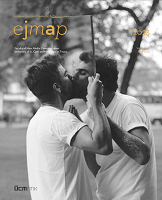The Body is Pivot
The Body is Pivot
Author(s): Tales FreySubject(s): Fine Arts / Performing Arts, Photography, Visual Arts, Cultural Essay, Sociology of Art, History of Art
Published by: Univerzita sv. Cyrila a Metoda v Trnave, Fakulta masmediálnej komunikácie
Keywords: Body; Experimental Arts; Gender; Identity; Performativity; Visual Arts
Summary/Abstract: Contradicting the scenario full of images and the frantic pace of succession of information from the current consumer society and its technologies, since 2006 – when Tales Frey conceived the work “O Beijo” in partnership with the artist Cristine Ágape – he has created a series of actions guided by the minimum use of resources so that the main elements gain the maximum symbolic potential in each artistic expression originated. Still in contrast to the operating principle of the present time regarding an excess of information, it seeks to extend the time in activating simple actions, sometimes proposing insistent, repetitive gestures with clear objectives and, sometimes, presenting the body almost inert in a simple standby mode. In the book “Tempo e Memória”, by Katia Canton, there is an excerpt from a speech by the artist Bill Viola taken from an interview granted to Marcello Dantas in his documentary “Processing the Signal” (New York, 1989) where the artist says that the world pushes us to make “things shorter and shorter”, suggesting “more information in less time”. Based on this notion, Bill Viola proposes to do just the opposite: “to show less and less information in more time”. Tales Frey strongly identifies with this notion of time dilation as a tactic to induce the audience to an acute reflection stimulated by the few proposed signs. As questions and possible conclusions emerge on the part of the audience, with the time of action dragged out, an insistent image starts to impel new forms of interpretation about it and, thus, the meanings vary, are confirmed and/or changed and contradict. Although Tales Frey does not intend to place his work of live performance in a specific category, he understands it in part as a plastic art in movement and even as a kind of kinetic sculpture, since he uses the human body as a support to create reliefs, define shapes and spaces, providing three-dimensionality to each work produced, often denying the relations with the classic frontality of the scenic arts and with the inert matter of the visual arts. As opposed to the idea of frantic movement, he names most of his works as choreographies that are not necessarily submissive to the imperative of kinetics. Thinking more broadly about his artistic practice, Frey emphasizes that performance is the most recurrent means of expression in his propositions, but he is very committed to establishing the notion of performativity in different means, for example, using video, photography, the object, and the installation, among others. Although he uses nomenclatures that surround a certain artistic expression, he is aware of a post-media condition marked by the crossing of languages in current practices and, in this sense, each expression proposed by him is always integrated with several others, without walls, without categorical and orthodox restrictions.
Journal: European Journal of Media, Art and Photography
- Issue Year: 11/2023
- Issue No: 1
- Page Range: 6-35
- Page Count: 30
- Language: English

